Introduction:
Friction is defined as” The force tangential to the common boundary of two bodies in contact that resists the motion of one over the other”[2] which can be either Static or Kinetic. Static friction is defined as the force required to initiate tooth movement, where as Kinetic friction is the force that resists motion.[3]
Numerous factors have been implicated in the literature that may influence frictional resistance which includes relative bracket wire clearance, arch wire size, wire composition, bracket width, bracket slot material, surface conditions of the arch wires and brackets, torque and angulations at the bracket wire interface, type of lubrication, method of ligation etc. Among all the factors, in clinical practice it is the type of ligature, wire material and the size of the arch wires used play an important role.[1]
The aims and objectives of the present study were- (a) To evaluate different ligatures and assess which ligature produced lowest frictional resistance. (b) To evaluate the influence of archwire material and archwire size on the frictional resistance.
Materials & Methods:
Brackets: 0.022”×0.028” stainless steel standard edgewise maxillary premolar brackets with zero degree tip and torque(Modern orthodontics,US)2. Elastomeric modules (a) Grey (3M Unitek, Monorovia, CA, USA) (b) Purple (3M Unitek, Monorovia, CA, USA) (c) Alastic (Easy-to-tie) (3M Unitek, Monorovia, CA, USA)3. Ligatures: (a) Stainless steel 0.09” (Modern orthodontics, US) (b) Teflon coated stainless steel ligature (Ortho organizer, San Marcos, California). 4. Arch wires:(a) 0.017”×0.025” Stainless steel.(Ortho organizer, San Marcos, California) (b) 0.017”×0.025” TMA (Ormco, Glendora) (c) 0.019”×0.025” Stainless steel. (Ortho organizer, San Marcos, California) (d) 0.019”×0.025” TMA(Ormco, Glendora) 5. Perspex blocks (FS, China) rectangular blocks of length -35mm, breath-25mm and thickness- 3.5mm. 6. Epoxy resin (Bond tite, Resinova chemical ltd, Kanpur) 7. Clear Self cure acrylic (DPI-RR ) 8. Mathieu ligature-tying Forceps (Skody) 9. Bracket holder (Skody) 10. Ligature cutter (Skody 11. Tweed plier (Skody) 12. Ligature tucker (Skody) 13.Orthodontic tubing ( 0.8mm diameter 14. Mixing pad and spatula 15. Straight fissure bur 16. Permanent marker (Luxor) 17. 95% ethanol (Kakatiya pharma, Hyd) 18. Syringe, 10ml disposable plastic syringe with 22 gauge hypodermic needle (Dispovan) 19. Whole human saliva.
200 Perspex blocks of length-35mm, breath-25mm and thickness-3.5mm (FS, China) were obtained. Two lines were drawn with a HB pencil, one line parallel
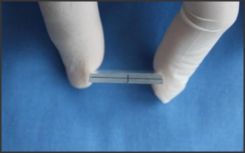 | Fig1 : Perspex block with orientation lines
 |
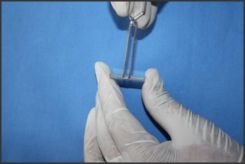 | Fig2: Positioning the bracket on Perspex block with the help of bracket holder
 |
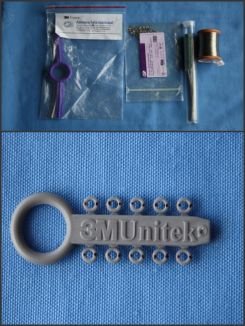 | Fig3 : Elastomeric, Stainless steel and Teflon coated stainless steel ligatures
 |
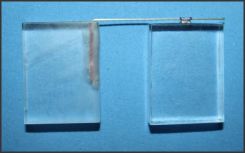 | Fig4 : Upper and lower Perspex blocks with the archwires ligated
 |
 | Fig5 : Universal testing machine (INSTRON Model No 4467 H 2066) with Perspex blocks, archwire and ligature assembly
 |
to the breadh of the block bisecting the thickness of the block and the second line was drawn bisecting the first line Fig 1. Thus a center point was obtained for attaching the brackets on that point. Similar lines were drawn on all 200 perspex blocks of same measurement. 200, 0.022”×0.028” stainless steel standard edgewise maxillary premolar brackets with zero degree tip and torque(Modern orthodontics, USA) were procured and were mounted on the blocks with the help of a bracket holder(Skody) (Fig 2).
The brackets were attached to the block with the help of epoxy resin (Bond tite, Resinova chemical ltd, Kanpur). Minute quantity of the resin was placed on the block with a dropper and the brackets were secured and placed on the blocks and were adjusted with the opposite end of the bracket holder, taking care that the brackets lie exactly on the point obtained after bisecting the breath of the block and allowed it to set.
10 straight length wires each of 0.017×0.025 and 0.019×0.025 inch stainless steel and TMA(β-titanium) supplied by Ormco and Ortho organizer respectively were obtained and were cut into 5 pieces of 60mm each. Thus 50 pieces of each wire were obtained.On each 60mm length of the archwires another marking was made at 10mm distance from one end of the archwires and a right angle bend was made using tweed plier.
In addition to the 200 blocks another block of same dimensions was prepared in such a manner that the 10mm end of the archwires will be placed inside the block. For preparing this block a 20 mm trough was made with a micromotor straight fissure bur traversing the length of the block. A 20mm length orthodontic tubing with an internal diameter of 0.8mm was placed inside the trough so that it lies parallel to the floor of the block. The orthodontic tubing was then secured to the blocks with clear self cure acrylic resin (DPI-RR).
The bracket and wires were held together with either one of three types of elastomeric module i.e. Gray(3M Unitek, Monorovia, CA, USA), Purple(3M Unitek, Monorovia, CA, USA), Alastic easy to tie modules (3M Unitek, Monorovia, CA, USA) incorporating 45° bend in it. Prior to Alastic placement, the position of the 45 degree bend was marked with a fine black permanent marker to ensure the correct orientation of the module to the wire, or Teflon coated stainless steel ligature (Ortho organizer, San Marcos, California) and preformed 0.09 inch Stainless steel ligature (Modern orthodontics, US) Introduction:
Friction is defined as” The force tangential to the common boundary of two bodies in contact that resists the motion of one over the other”[2] which can be either Static or Kinetic. Static friction is defined as the force required to initiate tooth movement, where as Kinetic friction is the force that resists motion.[3]
Numerous factors have been implicated in the literature that may influence frictional resistance which includes relative bracket wire clearance, arch wire size, wire composition, bracket width, bracket slot material, surface conditions of the arch wires and brackets, torque and angulations at the bracket wire interface, type of lubrication, method of ligation etc. Among all the factors, in clinical practice it is the type of ligature, wire material and the size of the arch wires used play an important role.[1]
The aims and objectives of the present study were- (a) To evaluate different ligatures and assess which ligature produced lowest frictional resistance. (b) To evaluate the influence of archwire material and archwire size on the frictional resistance.
Materials & Methods:
Brackets: 0.022”×0.028” stainless steel standard edgewise maxillary premolar brackets with zero degree tip and torque(Modern orthodontics,US)2. Elastomeric modules (a) Grey (3M Unitek, Monorovia, CA, USA) (b) Purple (3M Unitek, Monorovia, CA, USA) (c) Alastic (Easy-to-tie) (3M Unitek, Monorovia, CA, USA)3. Ligatures: (a) Stainless steel 0.09” (Modern orthodontics, US) (b) Teflon coated stainless steel ligature (Ortho organizer, San Marcos, California). 4. Arch wires:(a) 0.017”×0.025” Stainless steel.(Ortho organizer, San Marcos, California) (b) 0.017”×0.025” TMA (Ormco, Glendora) (c) 0.019”×0.025” Stainless steel. (Ortho organizer, San Marcos, California) (d) 0.019”×0.025” TMA(Ormco, Glendora) 5. Perspex blocks (FS, China) rectangular blocks of length -35mm, breath-25mm and thickness- 3.5mm. 6. Epoxy resin (Bond tite, Resinova chemical ltd, Kanpur) 7. Clear Self cure acrylic (DPI-RR ) 8. Mathieu ligature-tying Forceps (Skody) 9. Bracket holder (Skody) 10. Ligature cutter (Skody 11. Tweed plier (Skody) 12. Ligature tucker (Skody) 13.Orthodontic tubing ( 0.8mm diameter 14. Mixing pad and spatula 15. Straight fissure bur 16. Permanent marker (Luxor) 17. 95% ethanol (Kakatiya pharma, Hyd) 18. Syringe, 10ml disposable plastic syringe with 22 gauge hypodermic needle (Dispovan) 19. Whole human saliva.
200 Perspex blocks of length-35mm, breath-25mm and thickness-3.5mm (FS, China) were obtained. Two lines were drawn with a HB pencil, one line parallel to the breadh of the block bisecting the thickness of the block and the second line was drawn bisecting the first line Fig 1. Thus a center point was obtained for attaching the brackets on that point. Similar lines were drawn on all 200 perspex blocks of same measurement. 200, 0.022”×0.028” stainless steel standard edgewise maxillary premolar brackets with zero degree tip and torque(Modern orthodontics, USA) were procured and were mounted on the blocks with the help of a bracket holder(Skody) (Fig 2).
The brackets were attached to the block with the help of epoxy resin (Bond tite, Resinova chemical ltd, Kanpur). Minute quantity of the resin was placed on the block with a dropper and the brackets were secured and placed on the blocks and were adjusted with the opposite end of the bracket holder, taking care that the brackets lie exactly on the point obtained after bisecting the breath of the block and allowed it to set.
10 straight length wires each of 0.017×0.025 and 0.019×0.025 inch stainless steel and TMA(β-titanium) supplied by Ormco and Ortho organizer respectively were obtained and were cut into 5 pieces of 60mm each. Thus 50 pieces of each wire were obtained.On each 60mm length of the archwires another marking was made at 10mm distance from one end of the archwires and a right angle bend was made using tweed plier.
In addition to the 200 blocks another block of same dimensions was prepared in such a manner that the 10mm end of the archwires will be placed inside the block. For preparing this block a 20 mm trough was made with a micromotor straight fissure bur traversing the length of the block. A 20mm length orthodontic tubing with an internal diameter of 0.8mm was placed inside the trough so that it lies parallel to the floor of the block. The orthodontic tubing was then secured to the blocks with clear self cure acrylic resin (DPI-RR).
The bracket and wires were held together with either one of three types of elastomeric module i.e. Gray(3M Unitek, Monorovia, CA, USA), Purple(3M Unitek, Monorovia, CA, USA), Alastic easy to tie modules (3M Unitek, Monorovia, CA, USA) incorporating 45° bend in it. Prior to Alastic placement, the position of the 45 degree bend was marked with a fine black permanent marker to ensure the correct orientation of the module to the wire, or Teflon coated stainless steel ligature (Ortho organizer, San Marcos, California) and preformed 0.09 inch Stainless steel ligature (Modern orthodontics, US) Fig 3.
Using a Mathieu ligature-tying instrument, the Teflon-coated liagtures and stainless steel ligatures were cut into equal halves i.e. 40mm, after placing these ligatures at the bracket tie wings, they were pulled tightly and twisted to the point at which the pigtail began to double back on itself. Consequently, the pigtail was cut and bent under the archwire. 200 samples were made with different archwire and bracket combinations using different archwire ligatures.
A universal testing machine (INSTRON Model No 4467 H 2066) with a 5 kg load was used. The block with the bracket assembly consisting of archwires and different ligatures Fig 4 were mounted on the upper clamp of the machine which was a movable component. The block with the 20mm tubing was mounted to
 | The combinations tested were as follows:
 |
 | Table1: Mean and SD values in two wires and two materials according to five groups
 |
 | Table3 : Pair wise comparison of two wires by Tukeys multiple post hoc procedure
 |
 | Table 4: Pair wise comparison of two materials by Tukeys multiple post hoc procedure
 |
 | Table 5: Comparison of five groups in two different wires by Tukeys multiple post hoc Procedures
 |
 | Table 6: Comparison of five groups in two different materials (SS and TMA) by Tukeys multiple post hoc procedures
 |
the lower clamp which was a stationary component of the universal testing machine Fig 5. Each bracket and archwire assembly was oriented with the long axis of the slot vertical and in line with the direction of the load cell. All the archwires and brackets were washed in 95% ethanol and air dried prior to testing. Tests were conducted in the presence of fresh, whole human saliva which was obtained without stimulation and was dripped onto the bracket wire junction at a rate of 1 ml/minute from a syringe The cross head speed was set at 5mm/minute and each test run lasted for 4 minutes. Each bracket and arch wire combination
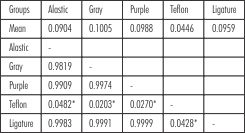 | Table2 : Pair wise comparison of five groups by Tukeys multiple post hoc procedure.
 |
was tested 10 times with each module type. Each combination was tested only once to eliminate the influence of wear and a total of 200 specimens were tested and the results were tabulated.
The test results were analyzed statistically using, 3 way ANOVA , pairwise comparison by Tukeys multiple post hoc procedure and regression analysis and conclusions were drawn.
Results:
The data was normally distributed and the results were tabulated and statistically analyzed using the S.P.S.S. 10 statistical analysis package software (SPSS Inc. Chicago Ill)
From Table 1. it was concluded that irrespective of wire size and combination Teflon coated stainless steel ligatures produced least frictional resistance and gray elastomeric modules produced the highest frictional force.Statistically significant values were found with Teflon and Alastic, Teflon and Gray, Teflon and Purple, Stainless steel ligature and Teflon in Pair wise comparison of five groups by Tukeys multiple post hoc procedure Table 2. It shows that Alastic ligature (MV-0.0904 has higher friction than Teflon 0.0482, gray elastomeric ligature (MV-0.1005) has higher frictional resistance than Teflon (MV-0.0203), Purple elastomeric ligature has higher frictional resistance than Teflon (0.0270), stainless steel ligature (MV 0.0428) and Teflon (0.0446) recorded decreased friction.
Pair wise comparison of two wire sizes and materials by Tukeys multiple post hoc procedure confirmed that 0.019”×0.025” wire size showed statistically significant value with a P value of 0.0087 but for two materials the values were not significant. It confirms that with the increase in the archwire size there was an increase in the frictional resistance and material composition has
 | Table 7: Comparison of two wires (17/25 and 19/25) and different materials (SS and TMA) by Turkeys multiple post hoc procedures
 |
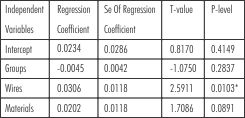 | Table8: Multiple linear regression analysis of static friction
 |
 | Table9: Relative contribution of Group, wires and materials
 |
negligible effect on frictional resistance. Tables 3 & 4.
Three way ANOVA with respect to groups i.e. the effect of different ligatures, different wire size and different material composition of the wires on static friction showed that main effects within the groups i.e. within the ligatures significant values wer0e found and wire sizes also showed statistically significant values but material composition of the archwires were not significant. Table 5.
Comparison of five groups in two different materials (SS and TMA) by Tukeys multiple post hoc procedure showed statistically insignificant values. It states that there was minimal or no effect of different ligatures on frictional resistaance when archwires of different material composition were used Table 6.
Comparison of two wire sizes (0.017”×0.025” and 0.019”×0.025”) and different materials (SS and TMA) by Tukeys multiple post hoc procedures showed statistically significant values
 | Graphs 1: Comparison of five groups in two wires with different materials with respect to coefficient of static friction
 |
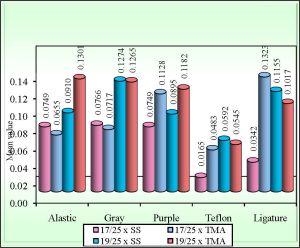 | Graph 2: Comparison of two wires with different materials in five groups with respect to coefficient of static friction
 |
between 0.019”×0.025” stainless steel and 0.017”×0.025” SS. It showed that 0.017”×0.025” SS produced lesser frictional resistance than 0.019”×0.025” SS. As regard the significant difference between 0.019”×0.025” TMA and 0.017”×0.025” SS it showed that 0.017”×0.025” SS wire has lower friction than 0.019”×0.025 TMA Table 7.
Multiple linear regression analysis of static friction between the independent variables ie Groups, archwire size and archwire material composition showed that only archwire wire size has significant influences on static friction with groups and materials showing minimum influence Table 8.
Percentage contribution of each independent variables showed that the percentage contribution of wires size was 3.2466% on static friction, the percentage contribution of archwire material showed 1.4117% and groups showed 0.5589 % contribution on static friction, which infer that wire size has maximum effect on frictional resistance followed by ligature groups and least with the material composition of the archwire Table 9
Discussion:
Robert P Kusy [5] had outlined that the purpose of the ligature during sliding was to retain the archwire within each bracket slot, not to press the archwire into the bracket. 7In the present study 200 perspex blocks were used for mounting the brackets in line with Balvinder Khambey, Declan Millet,Siobhan Mc Hugh[6] who used Perspex blocks in their frictional studies.
In our study a single bracket, ligature and arch wire combinations were studied. Simono Tecco,Stefano Tete, Felice Festa[7] used 10 aligned brackets of the same group which were bonded with cynoacrylate adhesive for evaluating frictional resistance. The brackets in our study were chosen to be with zero degree of tip and torque to allow the only friction present to be classical friction and not due to binding or notching. The crosshead speed of 5mm/min was based on the work of Kusy R P, Whitley J Q, Mahew M J, Buckhtal J E[8], who found that as sliding velocity decreased from 10mm per minute to 0.5×10-3 mm per minute, the coefficient of friction for stainless steel surfaces was relatively unaffected. Nigel G Taylor,Keith Ison [9] assessed frictional resistance of different bracket and archwire combinations in an universal testing machine with a speed of 5mm per min. Ariana pulido Guerrero, Odilon Guariza Filho, Orlando Tanaka, Elisa Souza Camargo, Sérgio Vieira[10] evaluated frictional resistance between different brackets and archwires of different alloys used universal testing machine with a cross head speed of 10mm per min and found consistant results.
All the tests were carried out in the presence of whole unstimulated saliva to replicate the clinical environment, in line with the recommendation of Kusy R P, Whitley J Q, Prewitt M G[11]. Artificial saliva has been shown to be an inadequate substitute for human saliva in friction studies conducted by Downing A, Mc Cabe J H, Gordon P H.[12] Tiziano Baccetti, Lorenzo Franchi[13] compared frictional forces of new nonconventional passive elastomeric ligatures and conventional passive elastomeric ligatures under dry conditions. Kevin L. Baker, Lewis G. Neiberg, Allan D. Weimer, Milford Hannashowed a reduction in friction between 15% to 19% under the presence of a saliva substitute (Xero-Lube).
The whole setup comprising of upper and lower Perspex blocks, the upper block with the archwire and the ligature, the lower block with 0.8mm diameter orthodontic tubing in which the short portion of the archwire placed was in accordance with the studies of Balvinder khambey, Declan Millet,Siobhan Mc Hugh[6].
Among the groups tested i.e. within different ligatures tested, Teflon coated stainless steel ligatures produced invariably less frictional resistance with all the wire size and material combinations used in this study, which is in accordance with the study conducted by David J. De Franco, Robert E. Spiller, J. A. Von Fraunhofer[14] who stated that the possible reduction in static frictional resistance of Teflon coated ligature was the result of the Teflon material possessing a lower coefficient of friction than the polyurethane elastomers.
Gray elastomeric ligature produced highest frictional resistance with all the archwire combination tested except 0.017×0.025 inch TMA. Purple showed lowest mean frictional force with 0.017”×0.025” SS. Downling P A, Jones W B, Lagerstrom L, Sandam J A[15] investigated the mean frictional forces of different coloured, shaped and manufactured modules when sliding a 0.018”x0.025” SS wire through a premolar bracket. The clear modules exihibited lower friction than other module types.
The 3M unitek Alastic Ligatures (Easy to Tie Ligatures ) incorperationg a 45° bend for easier placement of the ligature over the bracket tie produced higher frictional force with all the wires tested but lowest mean frictional resistance was recorded with 0.017 × 0.025 inch TMA. The commonly used stainless steel ligatures produced lowest frictional resistance with 0.017 × 0.025inch SS and 0.019 × 0.025 inch TMA but consistant higher mean values were found with 0.019 × 0.025 inch Stainless steel. Balvinder Khambay, Declan Millett and Siobhan McHugh[15] investigated the archwire seating force of different ligation methods, and its effect on frictional resistance using purple, grey, Alastik, and SuperSlick elstomeric ligatures and concluded that SS ligatures produced the lowest mean frictional forces, whereas grey modules produced significantly higher mean frictional force which is in accordance with our study.Young J, Sandrik JL[16] determined that the permanent deformation of elastomerics, related to time (stress relaxation), deformation of the ealastics as a result of hydrolysis due to water and moist heat in the oral environment, were reported to change the degree of frictional resistance.
Generally, friction appears to intensify with the increase of archwire diameter Kapila S, AngolkarP.V, Manville .G.Duncunson, Nanda Angolkar[17], a finding supported by the results of our study. For all specimens tested, the 0.019 × 0.025 inch wire produced higher friction than the 0.017 × 0.025 inch wire.
Among the two wire materials tested for frictional resistance no statistical significant was found between TMA and Stainless steel but the mean values show that TMA (0.0759) has higher mean frictional force than Stainless steel (0.0759). Kusy R P , Whitley J Q, Mayhew M J, Buckhtal J E[8] found using specular reflectance that stainless steel archwires are smother than cobalt chromium followed by TMA and Nickel titanium.Eleni Bazakidou, Ram S.Nanda, Manville G.Duncanson, Pramod Sinha[18] measured frictional resistance with different wire alloys and concluded that stainless steel produced least friction followed by TMA and nickel titanium.Kapila S, AngolkarP.V, Manville .G.Duncunson, Nanda, R.S[19] found that Stainless steel, Co-Cr, or ß-Ti wires that measured 0.019 × 0.025-inch produced statistically similar levels of friction that were lower than those produced by NiTi wires of the same size.
Conclusions:
The conclusions of the present study are as follows
(a) Teflon coated stainless steel ligatures produced lowest frictional forces with all wire, material combinations compared to the other ligatures followed by, Alastic ligatures, stainless steel ligatures, purple and grey elastomeric modules.
(b) Gray elastomeric modules produced the highest frictional resistance, while the other ligatures showed variable amounts depending on the wire, material, bracket combination.
(c) Statistically significant difference in frictional resistance was shown with increase in arch wire dimension. As the arch wire dimensions increased the static frictional resistance also increased.
(d) Though mean frictional resistance was more with TMA as compared to stainless steel there was no statistically significant difference.
References :
1. Chimenti.C, Lorenzo F, Maria Grazia Di Giuseppe, Lucci M.Friction of Orthodontic Elastomeric Ligatures with Different Dimensions.Angle Orthod. 2005;75:421–25.
2. Cash.A, R.Curtis, D.Garrigia-Majo,F.McDonald.A comparative study of the static and kinetic frictional resistance of titanium molybdenum alloy archwires in stainless steel brackets.European journal of orthodontics .2004;26:105-11.
3. Jack.B.S. Fiction and resistance to sliding in orthodontics : A critical review. Am J Orthod Dentofacial Orthop. 2009;135:442-47.
4. Dowling.P.A, W. B. Jones, L. Lagerstrom, J.A. Sandham. An investigation into behavioural characteristics of orthodontic elastomeric modules. British Journal Of Orthodontics. 1998;25:197-02.
5. Kusy.R.P, O’Grady P W. Evaluation of titanium brackets for orthodontic treatment: Part II—The active configuration Am J Orthod Dentofacial Orthop. 2000;118:675-84
6. Balvinder K, Declan M and Siobhan M H. Archwire seating forces produced by different ligation methods and their effect on frictional resistance.European Journal of Orthodontics. 2005; 27:302–08.
7. Simona T, Felice F, Sergio Caputi, Tonino Traini, Donato Di Iorio, Michele D’Attilio. Friction of Conventional and Self-Ligating Brackets Using a 10 Bracket Model. Angle Orthod. 2005;75:1041–45.
8. Kusy.R.P, O’Grady P W. Evaluation of titanium brackets for orthodontic treatment: Part II—The active configuration Am J Orthod Dentofacial Orthop. 2000;118:675-84
9. Nigel G.Taylor, Keith Ison .Frictional resistance between orthodontic brackets and archwires in the buccal segments. Angle Orthod. 1996;66(3):215-22.
10. Ariana P G, Odilon G F , Orlando T, Elisa S C , Sérgio Vieira. Evaluation of frictional forces between ceramic brackets and archwires of different alloys compared with metal brackets. Braz Oral Res.2010;24(1):40-45.
11. Kusy R P. Ongoing innovations in biomechanics and materials for the new millennium. Angle Orthod. 2000;70:366-76.
12. Downing A, Mc Cabe J F , Gordon P H . The effect of artificial saliva on the frictional forces between orthodontic brackets and archwires . British journal of Orthodontics. 1995;22:41-46.
13. Tiziano B, Lorenzo Franchi.Friction Produced by Types of Elastomeric Ligatures in Treatment Mechanics with the Preadjusted Appliance.Angle Orthod. 2006; 76:211–16.
14. David J . De Franco, Robert E. Spiller, J. A. Von Fraunhofer.Frictional resistances using Teflon-coated ligatures with various bracket-archwire combinations. Angle Orthod. 1995;65(1):63-74.
15. Dowling.P.A, W. B. Jones, L. Lagerstrom, J.A. Sandham. An investigation into behavioural characteristics of orthodontic elastomeric modules. British Journal Of Orthodontics. 1998;25:197-02.
16. Young J, Sandrik J L. The influence of preloading on stress relaxation of orthodontic elastic polymers. Angle Orthod. 1979; 49: 104–09
17. Kapila S, AngolkarP.V, Manville .G.Duncunson, Nanda, R.S. Evaluation of friction between edgewise stainless steel brackets and orthodontic wires of four alloys. Am J Orthod Dentofacial Orthop. 1990;98:117-26.
18. Bazakidou E, Nanda R S, Manville G.Duncanson, Pramod Sinha. Evaluation of frictional resistance in esthetic brackets. .Am J Orthod Dentofacial Orthop. 1997;112:138-44.
19. Kapila S, AngolkarP.V, Manville .G.Duncunson, Nanda, R.S. Evaluation of friction between edgewise stainless steel brackets and orthodontic wires of four alloys. Am J Orthod Dentofacial Orthop. 1990;98:117-26..
Using a Mathieu ligature-tying instrument, the Teflon-coated liagtures and stainless steel ligatures were cut into equal halves i.e. 40mm, after placing these ligatures at the bracket tie wings, they were pulled tightly and twisted to the point at which the pigtail began to double back on itself. Consequently, the pigtail was cut and bent under the archwire. 200 samples were made with different archwire and bracket combinations using different archwire ligatures.
A universal testing machine (INSTRON Model No 4467 H 2066) with a 5 kg load was used. The block with the bracket assembly consisting of archwires and different ligatures Fig 4 were mounted on the upper clamp of the machine which was a movable component. The block with the 20mm tubing was mounted to the lower clamp which was a stationary component of the universal testing machine Fig 5. Each bracket and archwire assembly was oriented with the long axis of the slot vertical and in line with the direction of the load cell. All the archwires and brackets were washed in 95% ethanol and air dried prior to testing. Tests were conducted in the presence of fresh, whole human saliva which was obtained without stimulation and was dripped onto the bracket wire junction at a rate of 1 ml/minute from a syringe The cross head speed was set at 5mm/minute and each test run lasted for 4 minutes. Each bracket and arch wire combination was tested 10 times with each module type. Each combination was tested only once to eliminate the influence of wear and a total of 200 specimens were tested and the results were tabulated.
The test results were analyzed statistically using, 3 way ANOVA , pairwise comparison by Tukeys multiple post hoc procedure and regression analysis and conclusions were drawn.
Results:
The data was normally distributed and the results were tabulated and statistically analyzed using the S.P.S.S. 10 statistical analysis package software (SPSS Inc. Chicago Ill)
From Table 1. it was concluded that irrespective of wire size and combination Teflon coated stainless steel ligatures produced least frictional resistance and gray elastomeric modules produced the highest frictional force.Statistically significant values were found with Teflon and Alastic, Teflon and Gray, Teflon and Purple, Stainless steel ligature and Teflon in Pair wise comparison of five groups by Tukeys multiple post hoc procedure Table 2. It shows that Alastic ligature (MV-0.0904 has higher friction than Teflon 0.0482, gray elastomeric ligature (MV-0.1005) has higher frictional resistance than Teflon (MV-0.0203), Purple elastomeric ligature has higher frictional resistance than Teflon (0.0270), stainless steel ligature (MV 0.0428) and Teflon (0.0446) recorded decreased friction.
Pair wise comparison of two wire sizes and materials by Tukeys multiple post hoc procedure confirmed that 0.019”×0.025” wire size showed statistically significant value with a P value of 0.0087 but for two materials the values were not significant. It confirms that with the increase in the archwire size there was an increase in the frictional resistance and material composition has negligible effect on frictional resistance. Tables 3 & 4.
Three way ANOVA with respect to groups i.e. the effect of different ligatures, different wire size and different material composition of the wires on static friction showed that main effects within the groups i.e. within the ligatures significant values were found and wire sizes also showed statistically significant values but material composition of the archwires were not significant. Table 5.
Comparison of five groups in two different materials (SS and TMA) by Tukeys multiple post hoc procedure showed statistically insignificant values. It states that there was minimal or no effect of different ligatures on frictional resistaance when archwires of different material composition were used Table 6.
Comparison of two wire sizes (0.017”×0.025” and 0.019”×0.025”) and different materials (SS and TMA) by Tukeys multiple post hoc procedures showed statistically significant values between 0.019”×0.025” stainless steel and 0.017”×0.025” SS. It showed that 0.017”×0.025” SS produced lesser frictional resistance than 0.019”×0.025” SS. As regard the significant difference between 0.019”×0.025” TMA and 0.017”×0.025” SS it showed that 0.017”×0.025” SS wire has lower friction than 0.019”×0.025 TMA Table 7.
Multiple linear regression analysis of static friction between the independent variables ie Groups, archwire size and archwire material composition showed that only archwire wire size has significant influences on static friction with groups and materials showing minimum influence Table 8.
Percentage contribution of each independent variables showed that the percentage contribution of wires size was 3.2466% on static friction, the percentage contribution of archwire material showed 1.4117% and groups showed 0.5589 % contribution on static friction, which infer that wire size has maximum effect on frictional resistance followed by ligature groups and least with the material composition of the archwire Table 9
Discussion:
Robert P Kusy [5] had outlined that the purpose of the ligature during sliding was to retain the archwire within each bracket slot, not to press the archwire into the bracket. 7In the present study 200 perspex blocks were used for mounting the brackets in line with Balvinder Khambey, Declan Millet,Siobhan Mc Hugh[6] who used Perspex blocks in their frictional studies.
In our study a single bracket, ligature and arch wire combinations were studied. Simono Tecco,Stefano Tete, Felice Festa[7] used 10 aligned brackets of the same group which were bonded with cynoacrylate adhesive for evaluating frictional resistance. The brackets in our study were chosen to be with zero degree of tip and torque to allow the only friction present to be classical friction and not due to binding or notching. The crosshead speed of 5mm/min was based on the work of Kusy R P, Whitley J Q, Mahew M J, Buckhtal J E[8], who found that as sliding velocity decreased from 10mm per minute to 0.5×10-3 mm per minute, the coefficient of friction for stainless steel surfaces was relatively unaffected. Nigel G Taylor,Keith Ison [9] assessed frictional resistance of different bracket and archwire combinations in an universal testing machine with a speed of 5mm per min. Ariana pulido Guerrero, Odilon Guariza Filho, Orlando Tanaka, Elisa Souza Camargo, Sérgio Vieira[10] evaluated frictional resistance between different brackets and archwires of different alloys used universal testing machine with a cross head speed of 10mm per min and found consistant results.
All the tests were carried out in the presence of whole unstimulated saliva to replicate the clinical environment, in line with the recommendation of Kusy R P, Whitley J Q, Prewitt M G[11]. Artificial saliva has been shown to be an inadequate substitute for human saliva in friction studies conducted by Downing A, Mc Cabe J H, Gordon P H.[12] Tiziano Baccetti, Lorenzo Franchi[13] compared frictional forces of new nonconventional passive elastomeric ligatures and conventional passive elastomeric ligatures under dry conditions. Kevin L. Baker, Lewis G. Neiberg, Allan D. Weimer, Milford Hannashowed a reduction in friction between 15% to 19% under the presence of a saliva substitute (Xero-Lube).
The whole setup comprising of upper and lower Perspex blocks, the upper block with the archwire and the ligature, the lower block with 0.8mm diameter orthodontic tubing in which the short portion of the archwire placed was in accordance with the studies of Balvinder khambey, Declan Millet,Siobhan Mc Hugh[6].
Among the groups tested i.e. within different ligatures tested, Teflon coated stainless steel ligatures produced invariably less frictional resistance with all the wire size and material combinations used in this study, which is in accordance with the study conducted by David J. De Franco, Robert E. Spiller, J. A. Von Fraunhofer[14] who stated that the possible reduction in static frictional resistance of Teflon coated ligature was the result of the Teflon material possessing a lower coefficient of friction than the polyurethane elastomers.
Gray elastomeric ligature produced highest frictional resistance with all the archwire combination tested except 0.017×0.025 inch TMA. Purple showed lowest mean frictional force with 0.017”×0.025” SS. Downling P A, Jones W B, Lagerstrom L, Sandam J A[15] investigated the mean frictional forces of different coloured, shaped and manufactured modules when sliding a 0.018”x0.025” SS wire through a premolar bracket. The clear modules exihibited lower friction than other module types.
The 3M unitek Alastic Ligatures (Easy to Tie Ligatures ) incorperationg a 45° bend for easier placement of the ligature over the bracket tie produced higher frictional force with all the wires tested but lowest mean frictional resistance was recorded with 0.017 × 0.025 inch TMA. The commonly used stainless steel ligatures produced lowest frictional resistance with 0.017 × 0.025inch SS and 0.019 × 0.025 inch TMA but consistant higher mean values were found with 0.019 × 0.025 inch Stainless steel. Balvinder Khambay, Declan Millett and Siobhan McHugh[15] investigated the archwire seating force of different ligation methods, and its effect on frictional resistance using purple, grey, Alastik, and SuperSlick elstomeric ligatures and concluded that SS ligatures produced the lowest mean frictional forces, whereas grey modules produced significantly higher mean frictional force which is in accordance with our study.Young J, Sandrik JL[16] determined that the permanent deformation of elastomerics, related to time (stress relaxation), deformation of the ealastics as a result of hydrolysis due to water and moist heat in the oral environment, were reported to change the degree of frictional resistance.
Generally, friction appears to intensify with the increase of archwire diameter Kapila S, AngolkarP.V, Manville .G.Duncunson, Nanda Angolkar[17], a finding supported by the results of our study. For all specimens tested, the 0.019 × 0.025 inch wire produced higher friction than the 0.017 × 0.025 inch wire.
Among the two wire materials tested for frictional resistance no statistical significant was found between TMA and Stainless steel but the mean values show that TMA (0.0759) has higher mean frictional force than Stainless steel (0.0759). Kusy R P , Whitley J Q, Mayhew M J, Buckhtal J E[8] found using specular reflectance that stainless steel archwires are smother than cobalt chromium followed by TMA and Nickel titanium.Eleni Bazakidou, Ram S.Nanda, Manville G.Duncanson, Pramod Sinha[18] measured frictional resistance with different wire alloys and concluded that stainless steel produced least friction followed by TMA and nickel titanium.Kapila S, AngolkarP.V, Manville .G.Duncunson, Nanda, R.S[19] found that Stainless steel, Co-Cr, or ß-Ti wires that measured 0.019 × 0.025-inch produced statistically similar levels of friction that were lower than those produced by NiTi wires of the same size.
Conclusions:
The conclusions of the present study are as follows
(a) Teflon coated stainless steel ligatures produced lowest frictional forces with all wire, material combinations compared to the other ligatures followed by, Alastic ligatures, stainless steel ligatures, purple and grey elastomeric modules.
(b) Gray elastomeric modules produced the highest frictional resistance, while the other ligatures showed variable amounts depending on the wire, material, bracket combination.
(c) Statistically significant difference in frictional resistance was shown with increase in arch wire dimension. As the arch wire dimensions increased the static frictional resistance also increased.
(d) Though mean frictional resistance was more with TMA as compared to stainless steel there was no statistically significant difference.
References :
1. Chimenti.C, Lorenzo F, Maria Grazia Di Giuseppe, Lucci M.Friction of Orthodontic Elastomeric Ligatures with Different Dimensions.Angle Orthod. 2005;75:421–25.
2. Cash.A, R.Curtis, D.Garrigia-Majo,F.McDonald.A comparative study of the static and kinetic frictional resistance of titanium molybdenum alloy archwires in stainless steel brackets.European journal of orthodontics .2004;26:105-11.
3. Jack.B.S. Fiction and resistance to sliding in orthodontics : A critical review. Am J Orthod Dentofacial Orthop. 2009;135:442-47.
4. Dowling.P.A, W. B. Jones, L. Lagerstrom, J.A. Sandham. An investigation into behavioural characteristics of orthodontic elastomeric modules. British Journal Of Orthodontics. 1998;25:197-02.
5. Kusy.R.P, O’Grady P W. Evaluation of titanium brackets for orthodontic treatment: Part II—The active configuration Am J Orthod Dentofacial Orthop. 2000;118:675-84
6. Balvinder K, Declan M and Siobhan M H. Archwire seating forces produced by different ligation methods and their effect on frictional resistance.European Journal of Orthodontics. 2005; 27:302–08.
7. Simona T, Felice F, Sergio Caputi, Tonino Traini, Donato Di Iorio, Michele D’Attilio. Friction of Conventional and Self-Ligating Brackets Using a 10 Bracket Model. Angle Orthod. 2005;75:1041–45.
8. Kusy.R.P, O’Grady P W. Evaluation of titanium brackets for orthodontic treatment: Part II—The active configuration Am J Orthod Dentofacial Orthop. 2000;118:675-84
9. Nigel G.Taylor, Keith Ison .Frictional resistance between orthodontic brackets and archwires in the buccal segments. Angle Orthod. 1996;66(3):215-22.
10. Ariana P G, Odilon G F , Orlando T, Elisa S C , Sérgio Vieira. Evaluation of frictional forces between ceramic brackets and archwires of different alloys compared with metal brackets. Braz Oral Res.2010;24(1):40-45.
11. Kusy R P. Ongoing innovations in biomechanics and materials for the new millennium. Angle Orthod. 2000;70:366-76.
12. Downing A, Mc Cabe J F , Gordon P H . The effect of artificial saliva on the frictional forces between orthodontic brackets and archwires . British journal of Orthodontics. 1995;22:41-46.
13. Tiziano B, Lorenzo Franchi.Friction Produced by Types of Elastomeric Ligatures in Treatment Mechanics with the Preadjusted Appliance.Angle Orthod. 2006; 76:211–16.
14. David J . De Franco, Robert E. Spiller, J. A. Von Fraunhofer.Frictional resistances using Teflon-coated ligatures with various bracket-archwire combinations. Angle Orthod. 1995;65(1):63-74.
15. Dowling.P.A, W. B. Jones, L. Lagerstrom, J.A. Sandham. An investigation into behavioural characteristics of orthodontic elastomeric modules. British Journal Of Orthodontics. 1998;25:197-02.
16. Young J, Sandrik J L. The influence of preloading on stress relaxation of orthodontic elastic polymers. Angle Orthod. 1979; 49: 104–09
17. Kapila S, AngolkarP.V, Manville .G.Duncunson, Nanda, R.S. Evaluation of friction between edgewise stainless steel brackets and orthodontic wires of four alloys. Am J Orthod Dentofacial Orthop. 1990;98:117-26.
18. Bazakidou E, Nanda R S, Manville G.Duncanson, Pramod Sinha. Evaluation of frictional resistance in esthetic brackets. .Am J Orthod Dentofacial Orthop. 1997;112:138-44.
19. Kapila S, AngolkarP.V, Manville .G.Duncunson, Nanda, R.S. Evaluation of friction between edgewise stainless steel brackets and orthodontic wires of four alloys. Am J Orthod Dentofacial Orthop. 1990;98:117-26. |